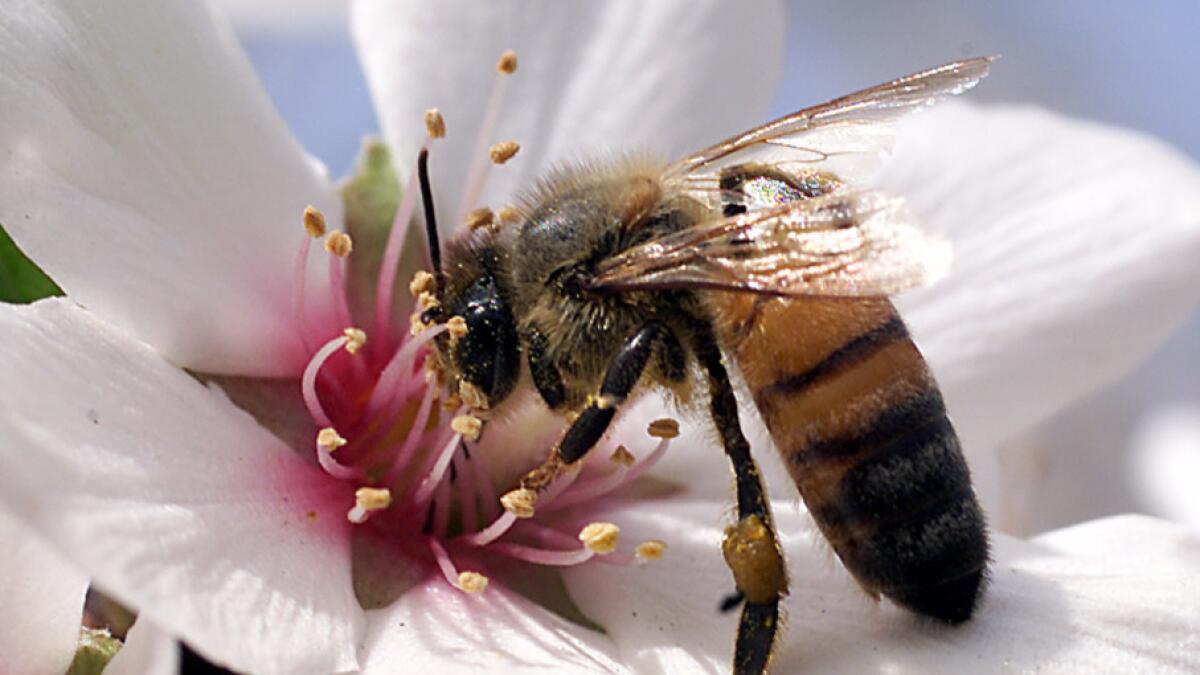Bee-harming pesticides are declining at plant nurseries, report shows

- Share via
Retailers appear to be selling fewer ornamental plants laced with pesticides linked to bee population declines, according to a new report.
Less than a quarter of the trees and flowers from stores and nurseries tested by environmental activists contained pesticides at levels that could be harmful to bees, which are vital to pollinating many of the nation’s food crops. Two previous reports, in 2013 and 2014, revealed that more than half of the samples contained potentially dangerous levels of chemicals linked to bee deaths.
“Our data indicates that compared to two years ago, fewer nurseries and garden stores are selling plants pre-treated with systemic neonicotinoid insecticides,” said Susan Kegley, a chemist at the Pesticide Research Institute and lead author of the report released Tuesday by the institute and Friends of the Earth.
Neonicotinoids, which mimic nicotine insecticides produced naturally in leafy plants, have been linked to the decline of bee populations.
In January, the U.S. Environmental Protection Agency said one such chemical, imidacloprid, “potentially poses risk to hives when the pesticide comes in contact with certain crops that attract pollinators.” Imidacloprid is found in at least 188 farm and household products in California.
Activists hailed recent pledges by such major retailers as Home Depot and Lowe’s to phase out neonicotinoids in the plants they purchase from nurseries, even as they urged others, such as Wal-Mart and True Value, to make similar moves. About 65 retailers, including Whole Foods and BJ’s Wholesale Club, have committed to phasing out neonicotinoid-treated plants, according to the report.
The pesticides are predominantly used to control sucking insects, such as aphids and psyllids, that damage the plants.
“The market is shifting away from selling bee-killing pesticides, and retailers including Ace Hardware and True Value are lagging behind their competitors,” said Tiffany Finck-Haynes, food futures campaigner with Friends of the Earth.
Jean Niemi, a spokeswoman for True Value Co., said the company is willing to phase out neonicotinoids when “suitable alternatives become commercially available.” In a letter sent to Friends of the Earth last year, the company said such a phase-out would occur over a three-year period.
A Wal-Mart spokesman said the company “has been monitoring the science around neonicotinoids” and bee health and will rely on the U.S. Environmental Protection Agency to assess the hazard posed by exposure to the chemicals.
A spokesman for Bayer CropScience, the primary manufacturer of Imidacloprid, said there is no evidence that proper use of neonicotinoids on home and garden products harms bees, and cautioned that losing home vegetation to insect damage can decrease habitat for the pollinators.
“Over its 20-year history, there has not been a single documented honey bee colony loss that can be attributed to a labeled use of imidacloprid,” said Bayer CropScience spokesman Jeff Donald.
“The unfortunate effect of the activists’ campaign is consumers who lose choice on how to protect their lawn and gardens, which may result in them losing plants and flowers to damaging pests or in them resorting to other costly or potentially more dangerous pest control measures,” Donald added.
Of the 60 samples taken nationwide — including several in the Bay Area and Sacramento — 14 showed traces of one or more neonicotinoid pesticides, mostly imidacloprid.
Three of 13 samples from city-owned landscaping also tested positive. Most of the samples that tested positive contained one pesticide; two flower samples contained two different neonicotinoid insecticides, according to the report.
California’s $7-billion almond industry depends almost completely on pollination services provided by bees. Other crops that depend strongly on commercial honeybee colonies include alfalfa, apples, avocados, blueberries, cherries, cucumbers, onions, cantaloupe, cranberries, pumpkins and sunflowers.
California farmers applied nearly 144 tons of imidacloprid on more than 1.5 million acres in 2013, the last year for which complete data were available, according to the state Department of Pesticide Regulation.
The top users of the pesticide were wine-grape growers, who applied 30 tons of it to about 240,000 acres in 2013, according to the state agency. Growers of table and raisin grapes, tomatoes for processing, oranges and cotton also were among the heaviest agricultural users, according to the agency.
The single biggest user, however, was the predominantly urban pest-control industry, which applied nearly 37 tons to homes and businesses to combat pests such as termites, according to the agency.
Several studies have linked high levels of neonicotinoids to decreased foraging, failures of queen bees, breakdowns in hive communication and other colony-threatening phenomena. Last year, however, a study suggested that exposure to levels of the pesticide expected on most farms would pose no significant negative effects on bee colonies.
Many factors have been blamed for the bee die-offs: exposure to multiple pesticides, poor hive management practices, loss of habitat and natural pathogens such as mites and viruses. The USDA last year reported winter colony losses of about 23%, based on a survey of beekeepers. A winter decline of about 19% is considered normal.
In May, the USDA reported a 17% loss of colonies from commercial beekeepers during the first quarter of this year. About 114,000 colonies were lost in a manner suggesting colony collapse disorder in that period, the USDA reported. That same quarter a year ago showed 92,300 colonies lost under similar circumstances.
Twitter: @LATgeoffmohan
ALSO:
Bees threatened by a common pesticide, EPA says
EPA bans a pesticide often used on almonds and other California crops
Court revokes approval of insecticide, citing ‘alarming’ decline in bees
UPDATES:
1:57 p.m.: This article was updated with comments from Bayer CropScience.
1:38 p.m.: This article was updated with a comment from Wal-Mart.
Wednesday, 12:30 p.m.: This article was updated with comments from True Value Co.
This article was originally published at 12:25 p.m.
More to Read
Inside the business of entertainment
The Wide Shot brings you news, analysis and insights on everything from streaming wars to production — and what it all means for the future.
You may occasionally receive promotional content from the Los Angeles Times.











